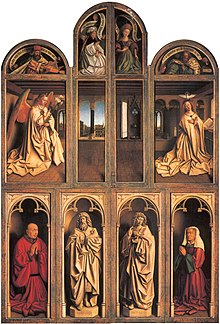
Back لوحة متعددة الدرفات Arabic Políptic Catalan Polyptych Czech Polyptychon German Poliptiko Esperanto Políptico Spanish Poliptiko Basque نقاشی چند لتهای (مرقع) Persian Polyptyykki Finnish Polyptyque French
This article needs additional citations for verification. (January 2024) |


A polyptych (/ˈpɒlɪptɪk/ POL-ip-tik; Greek: poly- "many" and ptychē "fold") is a work of art (usually a panel painting) which is divided into sections, or panels. Some definitions restrict "polyptych" to works with more than three sections:[1] a diptych is a two-part work of art; a triptych is a three-part work; a tetraptych or quadriptych has four parts. The great majority of historical examples are paintings with religious subjects, but in the 20th century the format became popular again for portraits and other subjects, in painting, photography, and other media.
Historically, polyptychs were panel paintings that typically displayed one "central" or "main" panel that was usually the largest; the other panels are called "side" panels, or if hinged, "wings". Folding forms were much more common north of the Alps. Sometimes, as evident in the Ghent Altarpiece and Isenheim Altarpiece, the hinged panels can be varied in arrangement to show different "views" or "openings" in the piece, because the wing panels are painted with images on both sides. The wings were usually kept folded shut, showing the "closed" view, except on Sundays or feast-days,[2] or if visitors paid the sacristan for a sight of the "open" view. The upper panels often depict static scenes, while the lower register, the predella, often depict small narrative scenes.

Large polyptychs were most commonly created as altarpieces in churches and cathedrals, although smaller diptychs and triptychs could be personal works for the rich, for example the royal Wilton Diptych, a very personal work made for Richard II of England. They had the advantage that they could be folded up to make them more secure from damage during travel. Another form was the carved ivory polyptych, most often religious, but with some secular subjects (these were more common on ivory boxes or mirrors).
When the altarpieces later came out of use, for a variety of reasons, they were often broken up and individual panels dispersed into the art trade, to be treated as easel paintings. Panels with paintings on both sides were often carefully sawn apart, to give two one-sided panels. Finding and reconstructing the parts of dispersed polyptychs has been the subject of much research in art history since the 19th century.
In medieval history, a different sense of the word is the polyptych meaning a document detailing the lands that a noble owned. Many also featured names of the peasants that lived there, allowing for historians to track the history of peasant families. The 9th-century monastic Polyptych of Irminon is an example.